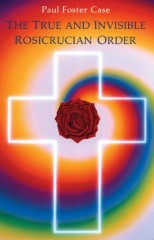
Author : Case Paul Foster
Title : The True and Invisible Rosicrucian Order
Year : 1933
Link download : Case_Paul_Foster_-_The_True_and_Invisible_Rosicrucian_Order.zip
ROSICRUCIANISM CAME INTO public notice early in the seventeenth century. The initial Rosicrucian manifesto, Fama Fraternitatis, was first issued as a manuscript and circulated among German occultists about the year 1610. It elicited several responses prior to the publication of the first printed edition at Cassel in 1614. In 1615 there was another printing, this time at Frankfurt-am-Main, and the same year and place seem to have seen the appearance of the second manifesto, Confessio Fraternitatis. Dutch translations of both books came out in 1615, and by 1617 four editions of the German version had been published at Frankfurt. Others followed in the years immediately succeeding. The Fama and the Confessio tell the story of the Order and its mysterious Founder and set forth its principles and philosophy. These tiny volumes aroused great interest. Alchemists and Qabalists, magicians and astrologers, kept the German presses busy with letters and essays addressed to the mysterious Brothers. For six or seven years the Rosicrucian question engaged the minds and pens of European occultists. In 1616 was published another little book, The Chymical Marriage of Christian Rosenkreutz. To it may be traced the supposition that the Order was founded by a man named Christian Rosenkreutz or by one who adopted this name as a mystical title. Years later, the authorship of The Chymical Marriage was acknowledged by Johann Valentine Andreae, who said it was a revision of an alchemical romance he had written in his youth, long before the publication of the Fama and the Confessio. The style of this work is altogether different from that of the two manifestoes. Andreae seems to have revamped The Chymical Marriage in the hope of profiting by the excitement stirred up by the two manifestoes. He was interested in schemes for universal reformation and may have planned to establish a secret society of his own. Like many others of that period, he was familiar with the literature of alchemy, and his romance shows that he had more than a smattering of occult learning. Yet the assertion that Andreae founded Rosicrucianism has no support in fact. Arthur Edward Waite has dealt adequately with this question in his Brotherhood of the Rosy Cross.1 We share his conviction that Andreae had no part in the authorship of either the Fama or the Confessio. Toward the close of his life Andreae ridiculed Rosicrucianism, and he probably never understood its real objectives. His book, however, roused great interest and fixed in the uncritical occult mind the mistaken notion that the Order was founded by a man named Christian Rosenkreutz. Even this name has been transformed by the carelessness that seems to be characteristic of a certain type of professed occultist. So little do some who write glibly about Rosicrucianism know of its origins that one writer tells his Theosophical readers the Founder's name was Christian Rosencrans. In 1652 Thomas Vaughan edited and published an English translation of the two manifestoes. In his preface, Vaughan declares that the translation is the work of an "unknown hand," and says, "The copy was communicated to me by a gentleman more learned than myself." This version was reprinted by Arthur Edward Waite in his Real History of the Rosicrucians, published in 1887. The same version, duly accredited to Waite's history, was printed in a manual issued in 1927 for members of the Societas Rosicruciana in America. By 1937 the Rosicrucian Fellowship at Oceanside, California, made belated acknowledgment of the existence of the manifestoes in a series of magazine articles. Possibly these manifestoes also may have been included in the miscellany of things Rosicrucian and otherwise printed at Quakertown, Pennsylvania, by Dr. R. Swinburne Clymer. Dr. Clymer offers voluminous documentary evidence that he is Grand Master of the Rosicrucian Order established by Pascal Beverly Randolph in 1856. Such as it is, few will seek to dispute this claim, for Randolph's titles to serious consideration may be judged by his own words. In Eulis (edition of 1874, page 47) he writes: "Very nearly all which I have given as Rosicrucian originated in my own soul." Among various publications of the society designated by the initials AMORC, there was a pamphlet entitled Fama Fraternitatis, but it was a strictly modern production, having no connection with the original manifesto apart from the title. The Rosicrucian name flourishes because few persons who are attracted by the magic name and fame of the Order have any knowledge of the first published utterances of the Fraternity. Thus, it seems wise to reprint the English translation again. The manifestoes are short. Their anonymous authors needed but few words to say their say, but no person properly qualified to understand these little books could have mistaken their true purport. On the other hand, they were so written that, as they put it, they would not "move gross wits." Nor have they, from that day to this. Minds duly and truly prepared can grasp what is hidden behind their story of the Order, and to help serious students of occultism to such understanding is the purpose of our work. Our title is intended to intimate that the Fama and the Confessio were written by members of an actual fraternity that conceals itself from all who are incompetent to share its aims and participate in its work. This fraternity is not an organized society like the Freemasons. One may not join it by making application for membership, paying entrance fees and dues, and passing through ceremonies. The Rosicrucian Order is like the old definition of the city of Boston: it is a state of mind. One becomes a Rosicrucian: one does not join the Rosicrucians. The manifestoes make this clear, as will be shown hereafter. The Order is designated as being invisible by the manifestoes themselves. It does not come in corporate form before the world, because by its very nature it cannot. True Rosicrucians know one another, nevertheless. Their means of recognition cannot be counterfeited nor betrayed, for these tokens are more subtle than the signs and passwords of ordinary secret societies. Let none suppose that because the Rosicrucian Order is invisible it is composed of discarnate human intelligences. Neither are its members supermen inhabiting a region vaguely designated by the term "higher planes." The Order is invisible because it has no external organization. It is not composed of invisible beings. Its members are men and women incarnate on earth in physical bodies. They are invisible to ordinary eyes because the minds behind those eyes cannot recognize the marks of a true Rosicrucian. To say this is, of course, to repudiate any and all pretensions of societies claiming to be direct historical successors to the authors of the original Rosicrucian manifestoes. From what is written in the Fama and the Confessio, the only possible conclusion is that every claim to historical descent, every assertion that this or that association is "the original Order," must be judged invalid. Probably some of these pretensions are made in good faith. There is reason to believe that societies calling themselves Rosicrucian were organized shortly after the publication of the manifestoes, and it is possible that they have continued in some form to this day. ...

Palmer Michael - Hiroshima revidiert
Author : Palmer Michael Title : Hiroshima revidiert Die beweise für napalm und senfgas anstatt...














